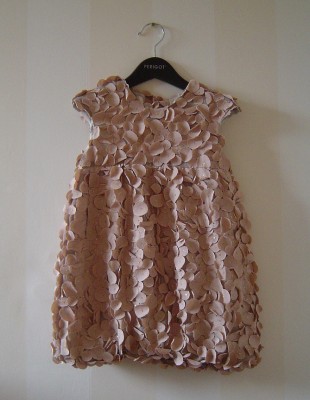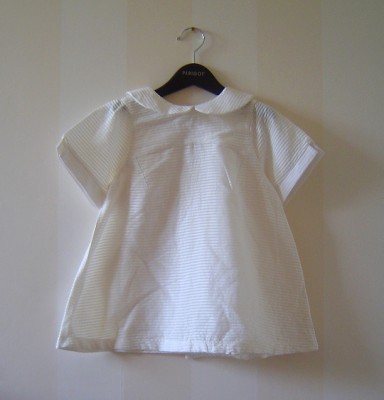Marie-Michelle Melotte is back with us today to finish the discussion we began earlier this week.
It’s clear that you’re not just picking out a pattern and then selecting a random printed fabric to make it. You’re really analyzing the specific style attributes of the design and then thinking about how you can create an interesting collaboration between the silhouette and a fabric in order to maximize the impact of the final garment. Where do you find the inspiration that helps you do this so well?
I grab inspiration wherever it comes from. I sketch it out lengthily and watercolor it, debating color, fabric and modifications. It usually starts with books. And ends in a museum!
I’ve gathered kilograms of books on art history, theatre costume and fashion design, costume institute catalogues, historical and folkloric dress, and fabric. If I could, I’d spend my life haunting the likes of the V&A and the Musée des arts décoratifs. To touch that eighteenth century brocade! Damn the glass display case!
Back in the day when I was just a shallow and covetous fashionista with no sewing skills, I amassed some exquisite, mommy-incompatible pieces that have provided inspiration along the way. Rifling through a closet, yours, someone else’s, window shopping, street gawking, and patio side ogling can jolt innovation and the creative process in strange and unexpected ways!
Yves Saint-Laurent and Courrèges are always good muses with their simple shapes, clean lines, perfect cuts, and impeccable design. What more can one ask for? When it comes to touch and architecture, Japanese designers are surefire stimulation. Kawakubo Rei, Yohji Yamamoto, and eccentricities such as those of Hussein Chalayan always make me smile. You might not use it but it will trigger something.
Speaking of inspiration, you made a Bubble Dress a while ago that began from a pretty interesting jumping off point.
The Titania bubble dress! A Midsummer Night’s Dream must be one of my least favorite of Shakespeare’s plays. I never quite grasped the pixie flutter although I was spellbound by the headstrong character of the fairy queen. Inspiration here was literally literary.
An odorous chaplet of sweet summer buds, field dew and sweet peace. A silk chiffon shift dress from Sportmax’s 2008 Spring/Summer collection covered in circular embroidered and sequined appliqués provided supplementary inspiration, and when I stumbled across this dusty rose silk and cotton appliquéd fabric on a German website, I thought its use on a Bubble Dress might quite possibly lead into the delightful world of the wood nymph!
One of the things that I find so interesting about your work is that you avoid prints and allow texture to do all the work of providing visual stimulation.
I am in awe of highly audacious colour combinations and almost hysterical histrionics such as can be found in collections by Kenzo and Christian Lacroix, but I am shy when it comes to pulling it off myself.
For the moment, I’m comfortable working with subdued color palettes where texture has the predominant role. A bit like in Italian tailoring, I like to let the fabric speak for itself. It always will if it’s well chosen and showcased.
Texture (more so than color) means depth, plays on perspective, the tantalizing theatre of light and shadow! How fun and exciting is that?! I have one dress in particular up on a pedestal when I’m thinking about texture in a neutral tone, Madame Grès’ Antigone dress at the Met Costume Institute. And one painting in mind, Jean-Baptiste Greuze’s La cruche cassée in the Louvre. Oh! The classical, not so virginal, bouillonné and twists of loveliness!
Tell us about the Puppet Show Tunic you made. There’s so much of interest going on in this garment, but there’s no print and no color.
This Puppet Show Tunic was made from an Alice + Olivia organic striped cotton and silk voile. The more opaque stripes are soft and slightly raised like on corduroy, leaving almost transparent and thinner stripes in between. Snap buttons covered with flat cotton mouliné buttons were used instead of buttonholes which I thought might weaken the delicate fabric with use.
The col claudine and puffed sleeves make this piece highly adorable and the pattern is one of my favorites. The fabric is soft, light and airy and I thought it would be interesting to use a somewhat “evanescent” cloth on a pattern with strong and well-defined elements, all in the name of contradiction.
You’re clearly unafraid to use high-end fabrics which is somewhat unusual for someone creating children’s clothing. Where do you find your fabrics?
I’m a fabric hound, constantly on the lookout! I spend a lot of time pouring through catalogues, and when I was still living in France, I made frenzied trips across the Channel.
Stragier in Belgium and MacCulloch & Wallis in the UK have true finds, although the price tag can quickly become quite steep. The US has some great shops (Emma One Sock, Waechter’s, Hyena, Gorgeous Fabrics) when it comes to finding affordable high end fabrics. I have a list of my favorite fabric and haberdashery suppliers in the sidebar of my blog listed under the heading “Fournitures Couture.”
I’m quite squirrelly in that I like to gather and collect items from everywhere around the world, oftentimes ending up with a very international garment. France, Belgium, Spain, Italy, England, Germany, India, the US, Canada. It’s all over the map. High end fabric, quality fabric, interesting fabrics can be found. You just have to dig for them and snap them up once they comes along as there isn’t an abundance of it that trickles out of the Ziploc of haute couture.
One is tempted to believe, based on history, savoir faire, and reputation that France must be a treasure trove full of lovely fabric. True. But it’s not available to the larger public. As with most things in Europe, the best is as hermetically self-contained as might be dandruff in Lagerfeld’s starched white coiffure. Open air markets, web shops, fabric boutiques, vintage clothing shops, estate sales, auctions, eBay, great-auntie’s attic, the remnants of your mother-in-law’s moth-eaten Chanel jacket. All and any of it can lead to the perfect find.
I only choose fabric with natural fiber content and use cotton and silk thread. To me, natural fabric feels fuller, richer, more real, and closest to life and I like to think that it’s a greener solution to man-made fabrics. Sometimes beauty can be very simple as long as you’re betting on quality. Do more with less, or so goes the minimalist motto. But maybe I’m too much of a purist.
Some of the high-end fabrics like these don’t lend themselves to the everyday wear and tear that most kids exert on their clothing. Are these garments you’ve been making more for show than for wear?
Most of the garments I make would be labeled “heirloom” or “special occasion” although that’s not my goal. I think it’s possible to dress children in things we’d initially like to think they shouldn’t wear, like silk and cashmere. Surprisingly or not, these fibers are quite hard-wearing. Sure, sweat suits are practical; throw them in the washer and you don’t even have to iron them! But they ain’t very pretty are they? If you’re wary of damaging clothing in your washing machine, then it should probably be washed by hand or handed over to the drycleaner. Better to spend a little time or money than ending up with a ruined garment.
Spot cleaning is also a good solution, especially on woolens. We often over-wash our clothes when sometimes a good airing out outside (also especially good for woolies) is quite sufficient to get clothes smelling of sunshine. (Please excuse the Stepford moment!) Natural fibers have a distinct smell that some people can find displeasing but that’s all part of the arrangement. Mother Nature has an olfactory label on her wares.
The boy things I make are for my son Félix, and it’s wholly endearing to see him out and about in something I’ve made. But my hands have always itched to make girly things, skirts that swing and oodles of dresses.
So my friends with girls get lucky around birthdays and Christmas! But I’m also looking at starting a small home business to sell the pieces that I make. It’s a way of gaining closet space and supporting my new-found sewing craze. Possibly, hopefully, soon there will be an e-shop.
You can follow Marie-Michelle’s creations on her blog Rastaquouère. She also contributes to the French language group blogs Oliver + S Lovers, C’est Dimanche Addicts, and Défi 13.


Thank you for posting this interview. I am enchanted. Those two bubble dresses are so inspiring.
This is pure bliss !
Have you also tried her cake recipes ?
I also enjoyed reading this interview. I found it very inspiring and beautifully put.
What a refreshing and thoughtful interview. Thank you
Her dresses (especially that petal dress) are inspiring. I’ve been thinking of making a few fancy versions of the bubble dress myself lately, and this is just the inspiration I need to go for it 🙂
I also love her philosophy that kids clothes can be made out of luxury fabrics because I agree with her – I am always so disappointed in the tulle and polyester creations I see in the stores. Natural fabrics are so much lovelier and wearable for all.
Thanks for featuring her! Inspiring 🙂
“the best is as hermetically self-contained as might be dandruff in Lagerfeld’s starched white coiffure”
I love this line so much! Can’t wait to see the e-shop, too.
Hello,
I saw the Tartan Day Dress pictured in the Sept/Oct issue of Sew Beautiful magazine and it is lovely. Where would I find detailed information regarding how to do the embroidery using the wool fabric? Thank you.
Zee Murphy
Zee, all that great customization was done by Marie Michelle. The article gave her blog address. You can find more information and contact her through that.